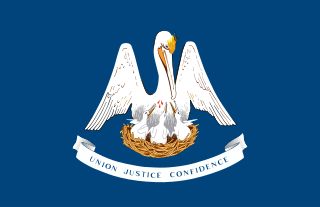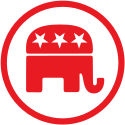
The New York State Legislature consists of the two houses that act as the state legislature of the U.S. state of New York. The New York Constitution does not designate an official term for the two houses together. It says only that "legislative power is vested in the senate and assembly." The session laws are published in the official Laws of New York. The permanent laws of a general nature are codified in the Consolidated Laws of New York. The legislature is seated at the New York State Capitol in Albany.

The Republican Party of Minnesota is a conservative political party in the U.S. state of Minnesota. It is affiliated with the United States Republican Party.
Political party strength in U.S. states refers to the level of representation of the various political parties of the U.S. in each statewide elective office providing legislators to the state and to the U.S. Congress and electing the executives at the state and national level.

The Wisconsin Legislature is the state legislature of the U.S. state of Wisconsin. The Legislature is a bicameral body composed of the upper house Wisconsin State Senate and the lower Wisconsin State Assembly, both of which have had Republican majorities since January 2011. With both houses combined, the legislature has 132 members representing an equal number of constituent districts. The Legislature convenes at the state capitol in Madison.

The 2008 United States House of Representatives elections were held on November 4, 2008, to elect members to the United States House of Representatives to serve in the 111th United States Congress from January 3, 2009, until January 3, 2011. It coincided with the election of Barack Obama as President. All 435 voting seats, as well as all 6 non-voting seats, were up for election. The Democratic Party, which won a majority of seats in the 2006 election, expanded its control in 2008. The Republican Party, hoping to regain the majority it lost in the 2006 election or at least expand its congressional membership, lost additional seats. With one exception, the only seats to switch from Democratic to Republican had been Republican-held prior to the 2006 elections. Republicans gained five Democratic seats total, while losing 26 of their own, giving the Democrats a net gain of 21 seats, effectively erasing all gains made by the GOP since 1994. In addition, with the defeat of a Republican congressman in Connecticut's 4th district, this became the first time since the 1850s that no Republican represented the New England region. The 10.6% popular vote advantage by the Democrats was the largest by either party since 1982, 26 years earlier. Turnout increased due to the 2008 presidential election. The presidential election, 2008 Senate elections, and 2008 state gubernatorial elections, as well as many other state and local elections, occurred on the same date.
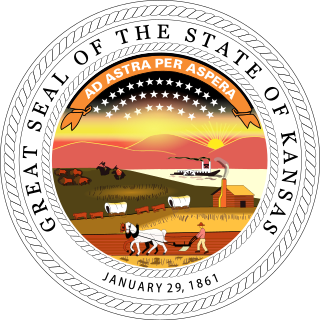
The Kansas Senate is the upper house of the Kansas Legislature, the state legislature of the U.S. State of Kansas. It is composed of 40 senators representing an equal number of districts, each with a population of at least 60,000 inhabitants. Members of the Senate are elected to a four-year term. There is no limit to the number of terms that a senator may serve. The Kansas Senate meets at the Kansas State Capitol in Topeka.

The 2010 United States elections were held on Tuesday, November 2, 2010, in the middle of Democratic President Barack Obama's first term. During this midterm election year, all 435 seats in the United States House of Representatives and 37 of the 100 seats in the United States Senate were contested, along with 39 state and territorial governorships, 46 state legislatures, four territorial legislatures and numerous state and local offices. Approximately 82.5 million people voted.

The 2002 United States elections were held on November 5, in the middle of Republican President George W. Bush's first term. Unusual in midterm elections, the incumbent president's party gained seats in both chambers of the United States Congress. The Republicans picked up net gains of 2 Senate seats and 8 House seats.
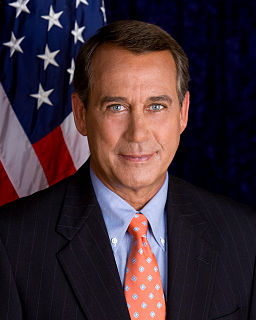
The 2010 United States House of Representatives elections were held November 2, 2010 as part of the 2010 midterm elections during President Barack Obama's first term in office. Voters of the 50 U.S. states chose 435 U.S. Representatives. Also, voters of the U.S. territories, commonwealths, and the District of Columbia chose their non-voting delegates. U.S. Senate elections and various state and local elections were held on the same date.

The 1998 United States elections were held on November 3, 1998 in the middle of Democratic President Bill Clinton's second term. The elections showed little change, and the composition in both houses of the United States Congress were not significantly altered.

The 2012 United States elections included many federal elections on Election Day, November 6, 2012, most prominently the 57th presidential election, Senate elections, and House of Representatives elections. It also featured 13 state and territorial governors' races; state and territorial legislature races, special elections, and various other state, territorial, and local races and referenda on votes held in November as well as throughout the year.

The 2001 United States elections were held on November 5 of that year. The 2001 recession was a dominant issue throughout the year as well as to a lesser extent the September 11 attacks and subsequent War on Terror, the latter of which would become especially important issue in the next year.
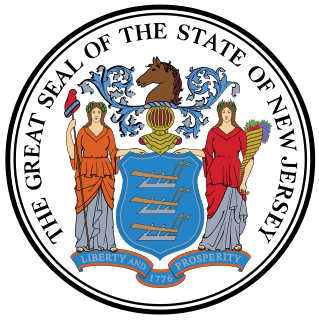
Elections were held in New Jersey on Tuesday, November 2, 2010. Primary elections were held on June 8, 2010.

The 2010 elections for the Oregon Legislative Assembly determined the composition of both houses for the 76th Oregon Legislative Assembly. The Republican and Democratic primary elections were on May 18, 2010, and the general election was held on November 2, 2010. Sixteen of the Oregon State Senate's thirty seats were up for election, as were all 60 seats of the Oregon House of Representatives.

The 2014 United States elections were held on Tuesday, November 4, 2014, in the middle of Democratic President Barack Obama's second term. During this midterm election year, all 435 seats in the United States House of Representatives and 36 of the 100 seats in the United States Senate were contested; along with 39 state and territorial governorships, 46 state legislatures, four territorial legislatures, and numerous state and local races. This midterm election became the most expensive in history, with total spending reaching $3.7 billion, while producing the lowest turnout since 1942 at only 36.4%.

The 2015 United States elections were held on Tuesday, November 3. The off-year election included a special election for Speaker of the House. There were also gubernatorial and state legislative elections in a few states; as well as numerous citizen initiatives, mayoral races, and a variety of other local offices on the ballot.

The 2016 United States elections were held on Tuesday, November 8, 2016. During this presidential election year, the President of the United States and Vice President were elected. In addition, elections were held for all 435 voting-member seats in the United States House of Representatives and 34 of the 100 seats in the United States Senate to determine the 115th Congress.

The 2018 United States elections were held Tuesday, November 6, 2018. These midterm elections occurred during the presidency of Republican Donald Trump. Thirty-five of the 100 seats in the United States Senate and all 435 seats in the United States House of Representatives were contested. Thirty-nine state and territorial governorships as well as numerous state and local elections were also contested.

The 2017 United States elections were held, in large part, on Tuesday, November 7, 2017. This off-year election featured gubernatorial elections in Virginia and New Jersey, as well as state legislative elections in both houses of the New Jersey Legislature and in the Virginia House of Delegates. Numerous citizen initiatives, mayoral races, and a variety of other local elections also occurred. Special elections were also held for one seat of the U.S. Senate, representing Alabama, and six seats of the U.S. House of Representatives.

The 2020 United States elections will be held on Tuesday, November 3, 2020. All 435 seats in the United States House of Representatives, 34 of the 100 seats in the United States Senate, and the office of President of the United States will be contested. Thirteen state and territorial governorships, as well as numerous other state and local elections, will also be contested.


